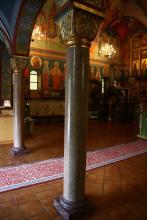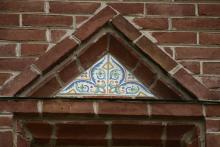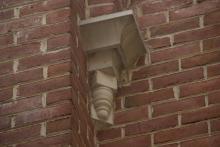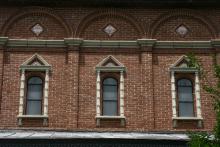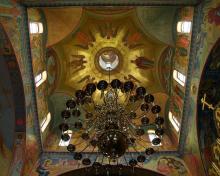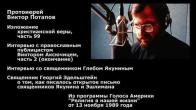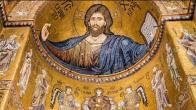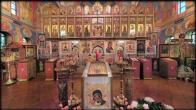You are here
06.01.10. “An Abundantly Gifted Bishop:” On the occasion of the 40th day of the death of His Grace Bishop Daniel (Alexandrow)
On Monday April 26, at the age of 79, His Grace the Most-reverend Daniel (born Dimitry Borisovitch Alexandrow), Bishop of Erie, a vicar to Metropolitan Hilarion, charged with shepherding ROCOR's Old Rite flock, departed to the Lord. He was an archpastor particularly dear to the parish of St. John the Baptist Cathedral in Washington, D.C., for he not only designed the cathedral, but personally worked on its construction.
Here is a brief biography of Bishop Daniel:
Official biographies of Bishop Daniel do not mention that his sister was a matushka, the wife of the famous Russian archpriest, Fr. Victor Shapovalnikov, who spent some time incarcerated with Alexandr Solzhenitsyn in a concentration camp. This is mentioned in The GuLag Archipelago.
From Archpriest Victor Potapov's, (rector of St. John the Baptist Cathedral), Recollections of Vladyka Daniel:
In 1974, soon after I became a priest and was assigned to my first parish in Stratford, Connecticut, I could look forward to the possibility of living not far from Vladyka Daniel (at the time, Archpriest Dimitry Alexandrow, not yet a monastic, lived and worked in the village of Churaevka, Connecticut), associating with him, and learning from him the basics of ancient Russian «kriuk» liturgical chant (the musical notation used special symbols called "kriuki," lit. "hooks"). Vladyka often visited my parish, and we agreed that I should come visit him to have a serious talk about «kriuk» chant.
On the appointed day, I left for Churaevka. I arrived at a not particularly attractive little two-story cottage in the woods. I knocked, but no one came to the door. I knocked more loudly, to no effect. Clearly, the owner was home, for his old car was in the yard. I opened the door, and walked in. From the second floor, there came the sound of ancient znamenny chant. As I ascended the steps to the second floor, I briefly glanced around the first floor. I was struck by the sight of a wide variety of construction tools, including metal-casting implements and tools used in ship-building... I made my way upstairs. Fr. Dimitry was sitting on a chair in the shop, writing an icon of the Protection of the Most-holy Theotokos, and at the same time chanting the service for that Feast, by heart. I apologized for entering his home without permission. Fr. Dimitry explained that he was getting a little deaf, and had not heard me knock.
I will never forget how Fr. Dimitry's home was furnished. On the walls there hung icons from the 16th, 17th, 18th and 19th Centuries, and ancient Royal doors. On shelves and tables, there was a multitude of manuscripts and ancient printed books. I asked the future Vladyka Daniel whether he was worried about security in his house — after all he had so many valuable holy icons and other things. "Just look at my house exterior! Its quite sorry condition is my most reliable security system."
On Fr. Dimitry's shelves there were also Arabic instruction textbooks, and reference books in Latin, Hebrew, and several other langauges. He showed me a Middle Eastern copper openwork lamp that he had recently purchased at an antique shop. It was engraved with an Arabic inscription, which Vladyka immediately read and translated for me. Vladyka was a theologian, iconographer, musicologist, linguist, historian, poet, architect, writer and a man of letters In his spare time he translated Krylov's Fables and composed his own quite witty fables about current events, including church life! (Later, each time that Vladyka would come to Washington in connection with the construction of our cathedral, he would take pleasure in acquainting us with his latest compositions. I hope that those literary gems have been preserved among his papers.
During our meeting, Vladyka told me of several projects in various stages of development. For example, he planned to cast a cannon in honor of the American Bicentennial, and on Independence Day, 1976, to fire a salute right there in his woods. He had also begun construction of a large sailboat on which he wanted to make a pilgrimage to the Holy Land...
Finally, the subject of our talk turned to kriuk chant. In response to my question as to whether it was difficult to learn such chant, Vladyka said, "Well no, it is quite easy." When I asked "what do you mean by easy?" Vladyka answered quite seriously, that it was just as easy as learning French.
There and then I realized that I would have to abandon my goal of becoming expert in kriuk chant.
* * *
Several years later, when I was already rector of the Cathedral of St. John the Baptist in Washington, we began the major rebuilding of the Cathedral - in the Muscovite-Yaroslavl style, based on plans drawn up by Vladyka Daniel. I remember that Vladyka loved to say that he was building the church in the same way that an iconographer prepares a board for his icon. Vladyka made detailed color sketches of the iconography planned for the walls, and prepared the wall surfaces for live frescoes, which he intended to do himself. Unfortunately, poor health interfered with those plans. Priest Theodore Koufos and the other iconographers who took part in decorating the walls of our church constantly used Vladyka's sketches as their reference in their efforts to bring his artistic plan into being.
Vladyka had envisioned every detail of the wall-painting that was to be in our church, and gave the carpenter explicit instructions as to the fashioning of the vaults, arches, and other internal architectural details of our church, bearing in mind what iconographic image would be painted on those arches, vaults, and walls. At times, it seemed extremely complex and impossible to fashion. It seemed impossible even to many of the carpenters we had wanted to hire to do the work. Thanks be to God, A. I. Gootan, for many years the head of our Parish Building Committee found Carlo, a talented Dutch master craftsman who was quick to understand Vladyka, and able to follow his every instruction.
As each phase of construction was completed, District inspectors would come to check the work, and each time would remark, "Excellent! This is a masterpiece!"
By the way, Vladyka did not have a formal degree in architecture. Truly, Vladyka's being a builder/architect was a gift from God.
* * *
During the years that our church was under construction (1978-1982) the musical director of the National Symphony Orchestra was the famous cellist Mstislav Leopoldovitch Rostropovitch. "Slava," as he was known by all of us who loved him, had a passionate love for all manner of construction. He was overjoyed to see that in the capital of the United States of America, a magnificent cathedral in an ancient Russian style was under construction, and he took part in the building effort. Whenever he came to the capital, he hurried to our church to see how construction was progressing. He loved to go up the scaffolding into the barrel vault, and was in awe of Vladyka Daniel's talent; he found a common language with him, not only in the realm of architectural building, but in the realms of music, literature and humor.
During one of these visits, Vladyka Daniel showed Rostropovitch how, at his direction, the builders were incorporating resonation chambers in the walls, as a means of improving the acoustics. Rostropovitch's admiration for Vladyka Daniel's abilities knew no bounds.
* * *
The late Vladyka greatly loved liturgical chant. The Lord gave him the gift of a pleasant baritone voice. Without fail, each time he came to Washington, he would ascend to the choir loft, assemble a group of men to chant, and would direct them in singing sticherae according to the Sputnik Psalomschika [The Chanter's Companion]. Sometimes, we found the chants unfamiliar; then he would sing the ancient znamennyand other old Russian chants by himself.
* * *
Vladyka's sermons were not of the usual variety. He was extremely well-read, and with the gift of enormous life experience, was always able to find in the given feast or saint's life, some jewel to pique the interest of his audience. This was a rare gift.
As already noted, Vladyka Daniel was not merely the designer of our cathedral; he often took an active part in its construction. One could often encounter him, an honored archpriest, dressed in work clothes, on the scaffolding. Among his accomplishements were the construction of our cupolas, personally cutting out and hammering into shape the many copper scales that cover our three cupolas, and teaching some parishioners how to gold-leaf those scales. Vladyka found two beautiful and very heavy granite columns, and brought them from New Jersey to Washington in his old automobile; today they enhance our narthex. He made the eight gold-leafed openwork panels below the lowest, "assembled" row of icons in our icon screen. Vladyka personally fashioned the ceramic tiles that decorate the exterior walls of the church barrel-vault, and was especially proud of the gold-leafed double-headed eagle pennant which he cut out of copper and mounted to the peak of our church's right tower.
In the early 1990s, we began construction of the passageway linking the church and the Parish Hall. This was several years after Vladyka had been consecrated Bishop of Erie, a vicar bishop in the Eastern American Diocese. We happened to be hosting a group of visiting Moscow Patriarchate clergy. Imagine the amazement of clergymen from Russia at being introduced to a bishop of the Russian Orthodox Church Outside of Russia, who was standing on the scaffolding and laying bricks!
* * *
In the early 1990s Archbishop Alexander of Korstroma came to visit us in Washington. He liked our church very much, and asked Vladyka Daniel to give him copies of his sketches, so that he might build a church just like ours in the Kostroma Diocese. Vladyka Daniel was willing to give him the drawings, but emphasized that the church should not be duplicated; he stressed that the design of the new church should take into account the limitations of the earlier one, and should be unique and better perfected.
* * *
Vladyka was always amazed by some people's concern and others' fear of the coming of antichrist. Their fear and concern caused him to be distressed, as he considered it a lack of faith. "Every day we read the 'Our Father,' and repeat the words 'Thy Kingdom come, Thy will be done,' but many people say those words without the requisite conviction. The coming of antichrist will mean that three years after His appearance, what true believers have longed for, Christ's Second Coming, will happen. Even so, come, Lord Jesus."
In this regard, Vladyka liked to call to mind an excerpt from the prayer of St. Basil the Great from the morning prayer rule: "And grant us to pass through the night of the whole present life with watchful heart and sober thought, ever expecting the coming of the bright and appointed day of Thine Only-begotten Son, our Lord and God and Savior, Jesus Christ, whereon the Judge of all shall come with glory to reward each according to his deeds. May we not be found fallen and idle, but watching, and upright in activity, ready to accompany Him into the joy and divine palace of His glory..."
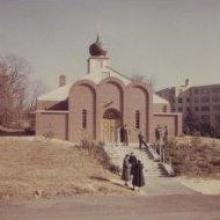 St. John's in Washington before its renovation by Bishop Daniel
St. John's in Washington before its renovation by Bishop Daniel
 St. John's after the renovation.
St. John's after the renovation.
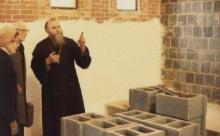 Fr. Dimitry (the future Bishop Daniel) discussing the renovation with parishioners
Fr. Dimitry (the future Bishop Daniel) discussing the renovation with parishioners
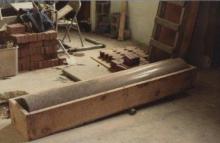 One of the massive granite columns brought by Bishop Daniel in his car
One of the massive granite columns brought by Bishop Daniel in his car
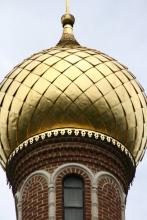 Gold-leafed copper scales on the central cupola made by Vladyka Daniel
Gold-leafed copper scales on the central cupola made by Vladyka Daniel
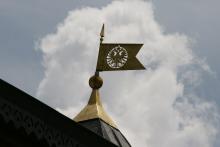 Gold-leafed double-headed eagle pennant made by Bishop Daniel)
Gold-leafed double-headed eagle pennant made by Bishop Daniel)
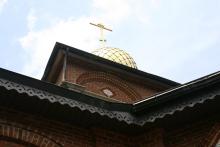 Detail of metal work by Vl. Daniel
Detail of metal work by Vl. Daniel
 Ceramic tiles designed by Vladyka Daniel
Ceramic tiles designed by Vladyka Daniel
 One of the iconostasis panels carved by Bishop Daniel
One of the iconostasis panels carved by Bishop Daniel
 Iconostasis designed by Vladyka Daniel
Iconostasis designed by Vladyka Daniel
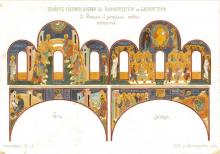 One of numerous sketches of church murals by Bishop Daniel
One of numerous sketches of church murals by Bishop Daniel
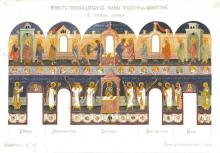 Another sketch of church murals by Bishop Daniel
Another sketch of church murals by Bishop Daniel
Media Office of the Eastern American Diocese
Relics in cathedral - monthly calendar
| S | M | T | W | T | F | S |
|---|---|---|---|---|---|---|
|
|
|
|
1
|
2
|
3
|
4
|
|
5
|
6
|
7
|
8
|
9
|
10
|
11
|
|
12
|
13
|
14
|
15
|
16
|
17
|
18
|
|
19
|
20
|
21
|
22
|
23
|
24
|
25
|
|
26
|
27
|
28
|
29
|
30
|
31
|
|
PARISH LIFE
Address of our Cathedral
While all the materials on this site are copyrighted, you may use them freely as long as you treat them
with respect and provide attribution on the Russian Orthodox Cathedral of St.John the Baptist of Washington DC.



